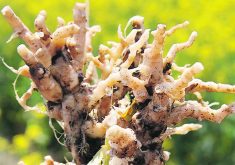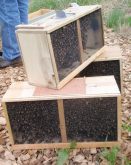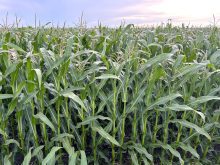Open housing for pigs and roomier cages for chickens aren’t cheap, nor are they likely to be the end of production changes
Within days of the wrap-up of this year’s National Farm Animal Care Council conference, news reports surfaced about a disturbing case of abusive treatment of layer chickens at two Alberta farms.
The controversy over the secretly filmed scenes shown on CTV’s “W5” was a reminder of the “strong emotions surrounding animal abuse,” said Jackie Wepruk, the council’s general manager.
It also drove home the importance of completing the codes, she said, noting work on the layer industry code won’t be finished before funding expires at the end of the year.
Read Also

Canola’s clubroot success story
At one time, scientists, agronomists and growers were extremely worried clubroot would spread across the Prairies and devastate Canada’s canola industry.
“So then we will be waiting in line to see if we can get the funding,” said Wepruk. “We have no idea when it might come through.”
The “W5” program showed hens, including dead ones, crowded in cages and chicks being killed by being hit against hard surfaces. The Egg Farmers of Canada called the practices shown in the video an “aberration,” CBC reported.
Reaction
But experts at the conference had warned that reacting to such incidents after the fact isn’t enough. They said the industry has to be proactive and step up efforts to talk to Canadians about what it is doing to promote humane treatment.
“We need to engage Canadians in an open, positive and honest conversation, like we’re sitting across from one another over coffee,” said Crystal Mackay, executive director of Farm & Food Care Ontario.
“Farming and food are not typically among the top-of-mind issues keeping consumers up at night. But their attitudes and perceptions related to agriculture do have an increasing impact on what they buy.”
But many producers are concerned about who will foot the bill for changes aimed at reducing public concerns about animal welfare.
Manitoba Egg Farmers have banned the installation of conventional cages after Dec. 31, 2014. While enhanced housing provides birds with more space, perches, scratching surfaces and private nesting boxes, they cost 20 to 25 per cent more. Hog producers face even higher costs — an extra $820 to $1,155 per sow — for group housing and reduced use of gestation crates. Add in additional labour and training costs, and it’s estimated the change could cost the Canadian pork industry $500 million.
Who pays?
Should those costs fall entirely on producers?
“How much of it is a public good and how much should commodity groups be expected to pay for?” Wepruk asked.
The new codes, along with an Animal Care Assessment Framework are “tremendous achievements,” said Dan Weary, an animal biology professor at the University of B.C.
But they also raise the bar, Weary told conference attendees.
“Canada is a world leader in the development of animal care codes and with that comes both rising expectations and new opportunities around farm animal care,” he said.
That’s why the codes need to be considered “a work in progress,” added Caroline Ramsay, the co-ordinator for the assessment framework, a tool for objectively determining whether the codes are benefiting animals.
“With them in place, we have to start asking where we go next,” she said. “Farm groups will have to think about the future now that this framework is in place and anticipate where the pressure for change will come from.”
The assessment framework is expected to be ready next year, and livestock groups will be required to use it. The process will be closely watched, she predicted.
“It’s likely the rest of the food chain will be pushing for an assessment of the effectiveness of the care programs,” said Ramsay.
Intense scrutiny
Scrutiny of the livestock industry is not only intensifying, but taking the sector on to new ground.
The livestock industry is under a lot of pressure from “the rest of the world” to get better at measuring animal pain, said University of Calgary professor, Ed Pajor, an expert in animal welfare and behaviour.
There are procedures for animals such as dehorning and castration to reduce suffering, but researchers are trying to accurately measure pain in livestock and looking at how it can be reduced further, if not eliminated, he said.
“Have we done everything possible to make the process animal welfare friendly?” Pajor asked conference attendees.
Among the alternatives under study is gene editing, which could produce animals requiring fewer stress-creating procedures. Pajor noted the EU wants to end castration of male pigs using current techniques by 2018.
“Pain mitigation in livestock production will be more important in the coming years,” he said. “That will include less stress for animals at weaning. We need more research on this and that will take time.”
In the meantime, farmers must look for ways to reduce animal stress, he added. “It would be a dangerous strategy for the industry to do nothing until more research can be conducted,” said Pajor.
“Agriculture is already regarded as being slow to change. Agriculture has to change to avoid animal welfare activists. Producers will be heavily scrutinized.”














